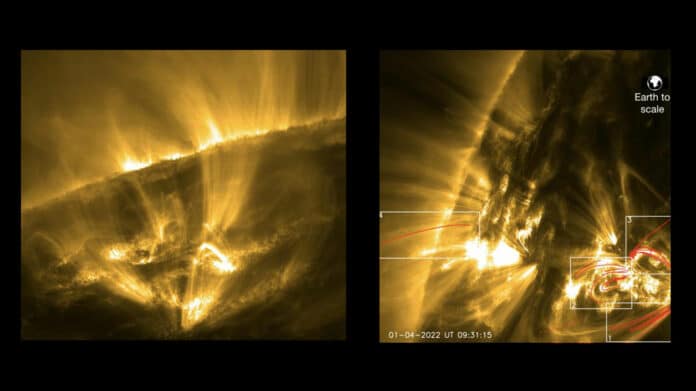The solar corona’s most striking cooling phenomenon is coronal rain. Recent investigations in the visible and ultraviolet range have demonstrated that coronal rain is common in active regions. It is a crucial diagnostic tool for the heating properties because of its strong connection to coronal heating via the thermal non-equilibrium (TNE) – thermal instability (TI) scenario.
A group of astronomers from various European universities, including Northumbria University in Newcastle, has discovered ‘Shooting Stars’ on the Sun. As part of the magnificent plasma displays known as coronal rain, observations from the European Space Agency’s Solar Orbiter (SolO) have discovered phenomena similar to “falling stars” or fireballs that resemble meteors that have never before been observed.
The gas that makes up the corona is heated to a million degrees, and sudden temperature reductions cause super-dense clumps of plasma to develop that can be up to 250 kilometers across. Gravity draws these fiery balls in at nearly 100 km/s, sending them tumbling back down towards the Sun.
This discovery is dedicated to SolO’s first close perihelion to the Sun. The highest spatial resolution of the solar corona has ever been attained thanks to SolO’s spring 2022 cruise to the Sun at a distance of only 49 million kilometers, or about a third of the distance between the Earth and the Sun.
SolO captured the first super-high-resolution pictures of the coronal rain clumps and saw the gas’s heating and compression right beneath them. The gas is heated to a million degrees during this brief period as they fall, as seen by the intensity spike that results below the clumps.
When meteoroids enter our atmosphere quickly and burn up, they produce “shooting stars” on Earth. Only a small percentage of meteors reach the Earth intact, and those that do can leave behind enormous craters. Scientists believe that most ‘ shooting stars’ come from the solar surface intact because the Sun’s corona is thin, low in density, and does not remove much material from the clusters. SolO’s observations have shown that this process can result in a fleeting, intense brightness with an upward surge of material and shock waves that reheat the gas above. Their impacts have never been seen before.
When hot material beneath the object is stripped off in a process known as ablation, “shooting stars” and meteors in Earth’s atmosphere leave a mark after their course. Comets orbiting the Sun experience the same thing. The magnetic field of the solar corona, however, prevents ablation from happening there. Instead, falling gas partially ionizes and travels along magnetic field lines, which serve as enormous tubes through which the gas is directed. It is far more challenging to photograph the phenomenon on the Sun because of the compression and heat beneath the clumps, which prevent them from creating tails.
The project’s lead author, Patrick Antolin, says: “The inner solar corona is so hot we may never be able to probe it in situ with a spacecraft. However, SolO orbits close enough to the Sun that it can detect small-scale phenomena occurring within the corona, such as the effect of the rain on the corona, allowing us a precious indirect probe of the coronal environment crucial to understanding its composition and thermodynamics. Just detecting coronal rain is a huge step forward for solar physics because it gives us important clues about the major solar mysteries, such as how it is heated to millions of degrees.”
“If humans were alien beings capable of living on the Sun’s surface, we would constantly be rewarded with amazing views of shooting stars, but we would need to watch out for our heads!”
Journal Reference:
- P. Antolin, A. Dolliou, F. Auchère et al. Extreme-ultraviolet fine structure and variability associated with coronal rain revealed by Solar Orbiter/EUI HRIEUV and SPICE⋆. Astronomy & Astrophysics. DOI: 10.1051/0004-6361/202346016
